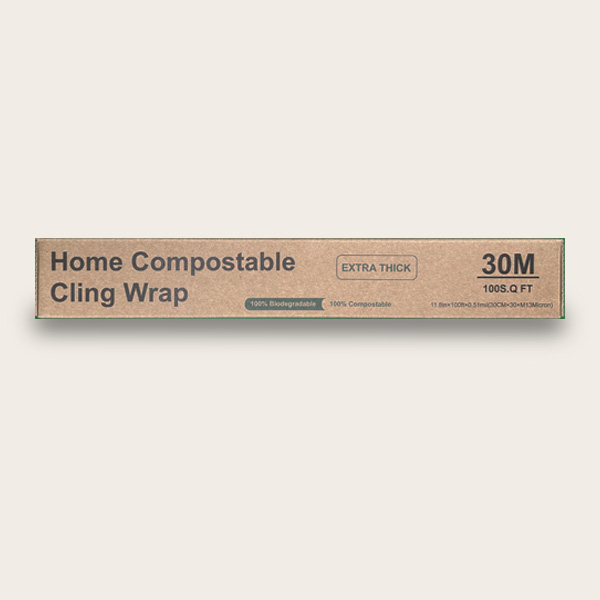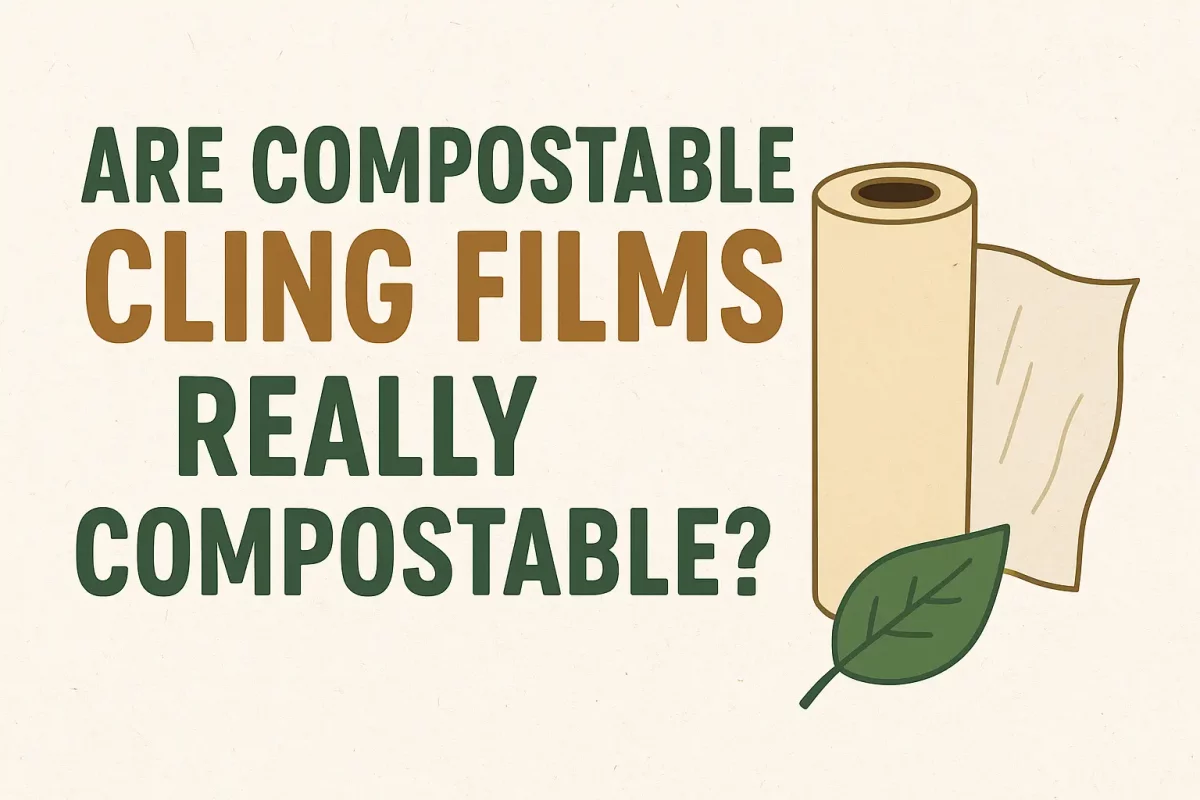Eco-Friendly Living
Are Compostable Cling Film Really Compostable? The Truth Revealed
Introduction
Cling film, also known as plastic wrap, has long been a household staple for keeping leftovers fresh and wrapping food on the go. The problem? Traditional cling film is made from petroleum-based plastics, which take hundreds of years to break down and often end up in oceans and landfills, contributing to the growing microplastic crisis.
This is where eco-friendly cling film comes in. Marketed as the eco-friendly alternative, it promises to break down naturally and leave no harmful residue. But here’s the question that many eco-conscious shoppers are asking: Is eco-friendly cling film really compostable—or is it just another greenwashed product? Let’s dig into the facts.
TL;DR: This post examines compostable cling film, highlighting that although it is made from plant-based polymers, it only truly breaks down in the correct composting environment. It emphasises the difference between home vs industrial composting, the importance of certifications (EN 13432, OK Compost), and warns that if it ends up in landfill or mixed recycling, it may behave like ordinary plastic.
What is Eco-Friendly, Compostable Cling Film?

Compostable cling film is designed to mimic the convenience of traditional plastic wrap while being gentler on the environment. Instead of petroleum-based materials, it’s made from plant-based polymers like PLA (polylactic acid), PBAT (polybutylene adipate terephthalate), and starch blends derived from renewable sources such as corn or potatoes.
These films look and feel like regular cling film, but the difference lies in their end-of-life journey. Under composting conditions, they are meant to break down into water, carbon dioxide, and nutrient-rich matter—without leaving behind toxic microplastics.
Still, not all compostable cling films are created equal. Some are designed for home composting, while others require industrial composting facilities to decompose fully. That’s where consumer confusion usually starts.
The Science Behind Compostability
To be considered compostable, a product must break down under the right conditions into natural elements that can safely return to the earth. Unlike simple biodegradation, which can leave behind microplastics, compostability demands complete breakdown into non-toxic soil.
This process relies on three main conditions:
- Heat: Industrial composting facilities maintain high temperatures (55–60°C) to accelerate the decomposition process.
- Oxygen: Aerobic conditions allow microbes to thrive and break down materials efficiently.
- Moisture: Proper humidity keeps the process active and prevents materials from drying out before decomposition.
Without these conditions, compostable cling film may not decompose as intended. For example, if tossed in a landfill, it won’t break down because landfills are anaerobic (low-oxygen) environments.
Are All Compostable Cling Films the Same?
Absolutely not. While all are marketed as “compostable,” the reality is nuanced. Some cling films are home compostable, meaning they can break down in backyard compost bins within 6–12 months. Others are industrially compostable, which means they require the high heat and controlled environment of commercial facilities to decompose properly.
If you use an industrial-only cling film at home, don’t expect it to vanish anytime soon. Instead, it may sit there for years, frustrating your sustainability goals. This is why reading the label—and understanding the difference—is so important.
Certifications to Look For
The easiest way to separate genuinely compostable films from greenwashed impostors is by checking for certifications. Look for:
- EN 13432 (European Standard): Ensures the product breaks down in industrial composting without leaving harmful residues.
- OK Compost (TÜV Austria): Two levels—Industrial and Home—depending on where it can be composted.
- ASTM D6400 (U.S. Standard): Guarantees compostability under specific conditions.
If a cling film doesn’t carry one of these marks, be cautious. Labels like “eco-friendly” or “biodegradable” don’t necessarily mean compostable.
Can Compostable Cling Film Decompose in Landfills?
Here’s the reality check: No, compostable cling film does not decompose in landfills. Landfills are compacted, oxygen-starved environments that lack the heat and airflow needed for composting. Instead, compostable films may sit intact for decades, just like regular plastics.
This highlights a major flaw in how compostable packaging is marketed. Many consumers assume that buying compostable cling film automatically reduces plastic pollution. In truth, unless the film is disposed of properly, it might end up being just as problematic.
Environmental Impact of Eco-Friendly Cling Film
The benefits:
- Made from renewable resources instead of fossil fuels.
- Reduces dependence on petroleum-based plastics.
- If properly composted, it leaves no toxic residue or microplastics.
The drawbacks:
- Often requires industrial facilities not available everywhere.
- Higher production costs compared to traditional cling film.
- There is a risk of contamination in recycling streams if disposed of incorrectly.
So, while compostable cling film is a step forward, it’s not a magic bullet for plastic pollution.
Home Composting: Does Cling Film Break Down?
If you’re a home composter, this is where things get tricky. Some compostable cling films are indeed home-compostable, but many are not. Even when they are, decomposition in a backyard bin can take significantly longer than advertised—sometimes over a year—depending on factors like:
- Seasonal temperatures (colder climates slow the process).
- The balance of carbon and nitrogen in the compost heap.
- Whether the film is cut into smaller pieces for faster breakdown.
For consumers expecting a quick turnaround, this can be disappointing.
Industrial Composting: The Safer Route
Industrial composting facilities are designed to handle materials like compostable cling film. Under these controlled conditions, films can break down completely in 90–180 days. The downside is accessibility—many areas lack such facilities, and curbside collection for compostable packaging isn’t always available.
This means that unless you live in a city with the right infrastructure, your compostable cling film may not achieve its eco-friendly potential.
Common Misconceptions
- “Compostable means it breaks down anywhere.” False—compostable products require specific conditions.
- “It’s always better for the environment.” Not necessarily—manufacturing compostable plastics still consumes energy and resources.
- “If it says eco-friendly, it’s compostable.” Misleading—eco-friendly is a vague marketing term.
How to Dispose of Compostable Cling Film Properly
Disposal is everything. If you want compostable cling film to actually help the planet:
- Check the certification—is it home or industrial compostable?
- Use the right bin—if your council collects compostable waste, that’s the best option.
- For home compostable films—cut into small strips and add to your compost bin.
- Avoid recycling bins—compostable plastics contaminate traditional recycling streams.
Alternatives to Compostable Cling Film
While compostable cling film is better than traditional plastic, there are even more sustainable options:
- Beeswax wraps – Reusable, natural, and compostable at home.
- Silicone lids and stretch covers – Long-lasting and washable.
- Glass or stainless-steel containers – Zero waste, durable, and ideal for long-term use.
These alternatives reduce dependency on single-use wraps altogether.
What to Check Before Buying Compostable Cling Film
Before you grab that roll of compostable film off the shelf, ask yourself:
- Does it carry trusted certifications (EN 13432, OK Compost, ASTM D6400)?
- Is it clearly labelled as home compostable or industrial only?
- Does your area provide compostable waste collection services?
If the answer to the last question is no, it may be worth considering reusable alternatives instead.
The Future of Compostable Packaging
The future is promising. Scientists are experimenting with algae-based films, mushroom packaging, and cellulose wraps that are more efficient and break down faster in natural environments. Governments are also tightening regulations on labelling, ensuring that products marked “compostable” actually meet strict standards.
As innovation continues, compostable cling film will likely become more accessible, affordable, and effective.
Conclusion
So, are compostable cling films really compostable? Yes—but only under the right conditions. If certified and sent to the correct composting stream, they can break down and return safely to nature. But if tossed in a landfill or recycling bin, they are little better than regular plastic.
The takeaway is clear: compostable cling film is not a free pass—it’s part of a bigger shift toward responsible consumption and disposal. Choosing wisely and disposing properly makes all the difference.
Make the Switch with Boring Basics UK
Ready to ditch single-use plastics for good? At Boring Basics UK, we offer eco-friendly everyday essentials like eco-friendly compostable cling film, biodegradable ziplock bags, and reusable alternatives that help you cut waste without cutting convenience.
Explore our range today at boringbasics.uk and take the next step toward a greener kitchen and a cleaner planet.
Frequently asked questions
Yes, compostable plastics are really compostable—but only under the right conditions. Most compostable plastics are designed to break down in industrial composting facilities, where high heat and controlled environments help them decompose into water, CO₂, and organic matter. However, not all compostable plastics will break down in home compost bins. To be sure, always look for certifications like EN 13432, ASTM D6400, or OK Compost HOME, which confirm how and where the material can be composted.
Traditional cling film made from PVC or polyethene is not compostable and can take hundreds of years to break down. Some newer plant-based compostable cling films do exist, but most require industrial composting to decompose fully. If the cling film packaging says “OK Compost HOME,” it can safely go in your garden compost. Otherwise, it belongs in food waste bins that go to industrial composting—not in recycling or landfill.
Cling film is considered problematic because it is a single-use plastic that creates huge amounts of waste. Standard cling film is difficult to recycle, often ends up in landfills, and can release microplastics into the environment. That’s why many people are turning to eco-friendly alternatives such as beeswax wraps, silicone lids, and compostable cling film. These sustainable options help reduce plastic pollution and make everyday food storage more environmentally friendly.
Traditional cling film can take hundreds of years to decompose in a landfill, making it a significant contributor to long-term plastic waste. By contrast, certified compostable cling film can decompose in as little as 6 months in industrial composting facilities. At home, though, unless it’s certified “home compostable,” it may take much longer—or may not break down fully at all.


